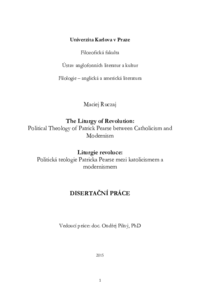The Liturgy of Revolution: Political Theory of Patrick Pearse between Catholicism and Modernism
Liturgie revoluce: Politická teologie Patricka Pearse mezi katolicismem a modernismem
dizertační práce (OBHÁJENO)

Důvod omezené dostupnosti:
Přílohy práce nebo její části jsou nepřístupné v souladu s čl. 18a odst. 7 Studijního a zkušebního řádu Univerzity Karlovy v Praze ve spojení s čl. 9 opatření rektora č. 6/2010.
Zobrazit/
Trvalý odkaz
http://hdl.handle.net/20.500.11956/65458Identifikátory
SIS: 103710
Kolekce
- Kvalifikační práce [23976]
Autor
Vedoucí práce
Oponent práce
Markus, Radvan
Ní Ghaibhí, Róisín
Fakulta / součást
Filozofická fakulta
Obor
Anglická a americká literatura
Katedra / ústav / klinika
Ústav anglofonních literatur a kultur
Datum obhajoby
22. 6. 2015
Nakladatel
Univerzita Karlova, Filozofická fakultaJazyk
Angličtina
Známka
Prospěl/a
Klíčová slova (česky)
Patrick Pearse, nacionalismus, Irské dějiny, Irská literatura, modernismus, katolicismus, politická filosofieKlíčová slova (anglicky)
Patrick Pearse, nationalism, Irish history, Irish literature, Modernism, Catholicism, Political PhilosophyVelikonoční povstání v Dublinu v roce 1916 je často popisováno s důrazem na prolínání nacionalismu a náboženské symboliky spásy skrze utrpení. Právě silná přítomnost náboženského diskurzu v odkazu lídra a hlavního ideologa povstání, Patricka Pearse, byla hlavní příčinou jeho posmrtného "vítězství" - Velikonoční povstání bylo vnímáno jako základní stavební kámen identity nového Irska. Ze stejných důvodů byl však také odsuzován, a to jako duchovní otec militantního a sektářského křídla irského republikanismu ve 20. století. Tato politizace debaty o Pearseově odkazu způsobila, že jen vzácně bylo jeho myšlení zkoumáno sine ira et studio. Tato disertace, po obecném uvedení do problematiky recepce Pearsova myšlení a teoretickém a historickém vymezení vztahů mezi nacionalismem a náboženstvím v evropském a irském kontextu, se zaměřuje na nové přezkoumání náboženských základů Pearsova myšlení o národu a nacionalismu. Pearsův nacionalismus je prezentován jako syntéza náboženských motivů a romantických a modernistických vlivů. Jeho základem je dynamický mechanismus transpozice symbolů a motivů ze sféry teologie do uvažování o národu, který nazývám translatio sacrii. Působení tohoto mechanismu je dokládáno analýzou řady Pearsových politických pamfletů a literárních děl, především z posledního období jeho...
Dublin Easter Rising of 1916 is widely recognized as an example of an intersection between nationalism and religion due to its use of the Christian symbolism of redemption via sacrifice. The religious aura, surrounding its leader and main ideologue, Patrick Pearse, was both a source of his posthumous "triumph" - the Irish independence shaped to a large extent by his legacy, and his "black legend" of the spiritual father of the sectarian violence in the twentieth century Irish politics. Due to the high degree of politicization of the debate over Pearse's role in Irish history, his intellectual legacy was rarely treated sine ira et studio. After a delineation of the problematic legacy of Pearse in the context of Irish Studies and the general introduction to the theme of the relations between nationalism and religion, this work proceeds to the re-examination of the place of religion in Pearse's thought. Pearse's conceptualization of Irish nationalism should be perceived as a synthesis emerging from the interplay between his deep indebtedness to the religious mind-frame and the Romantic and modernist influences that shaped the atmosphere of the pre-1914 Europe. It is based on a structural analogy between the Church and the nation. The analogy is created by means of a mechanism of the transposition of...
